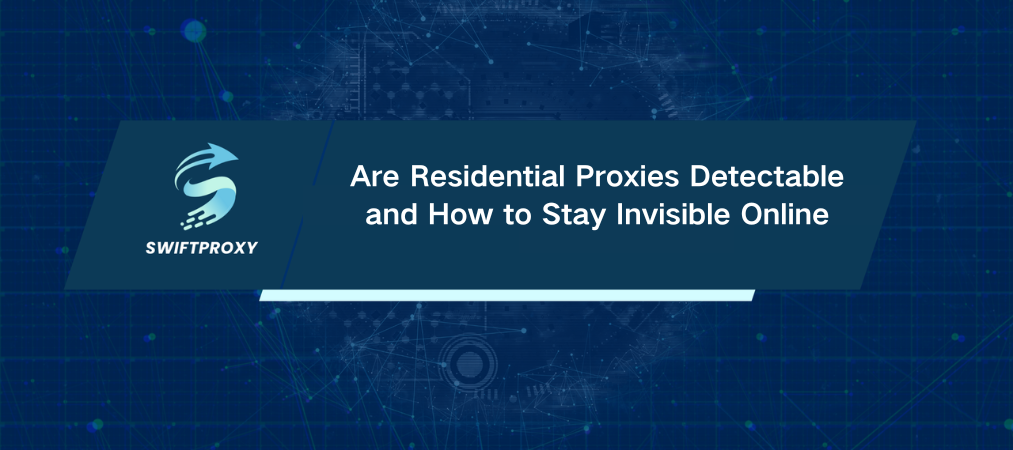Are Residential Proxies Detectable and How to Stay Invisible Online

In a world where online privacy is more important than ever, residential proxies are a game-changer. They offer a seamless way to access restricted content, collect data, and protect your identity. But, let's face it, the big question on everyone's mind is: Are residential proxies detectable?
The answer isn't black and white. While residential proxies are harder to detect than their datacenter counterparts, they aren't completely immune. But don't worry—this guide breaks down the reality of proxy detection, how websites try to flag proxies, and most importantly, how you can reduce your risk of detection.
What Exactly Are Residential Proxies
Residential proxies are like your stealthy online bodyguard. They route your internet traffic through real, geographically specific IP addresses assigned to residential devices (think home routers). These IP addresses are issued by Internet Service Providers (ISPs), so they look just like regular user traffic.
Unlike datacenter proxies—which come from servers in data centers—residential proxies have that real user feel. This authenticity makes them much harder to flag.
Why You Can Trust Swiftproxy's Residential Proxies
Let's talk about quality. Swiftproxy offers over 90 million residential IPs from legitimate ISPs. That's not just a big number—it means your proxy traffic is as real and authentic as it gets. Features like geo-targeting and unlimited concurrent sessions ensure that you can operate smoothly and with minimal risk of detection.
Is It Possible to Detect Residential Proxies
Yes, but let's break it down. Residential proxies aren't invincible, but they are more stealthy than others, especially datacenter proxies. Websites have detection tools, but the beauty of residential proxies lies in their source: real devices connected through ISPs. This gives them a legitimate appearance that's tough to flag.
However, detection still depends on various factors. The quality of your proxy provider, your online activity, and the methods websites use to spot proxies all play a role. High-quality providers, like Swiftproxy, help you stay under the radar by offering transparent, well-maintained IPs.
How Websites Track and Detect Proxies
Websites are getting smarter. Here's how they might catch you:
IP Reputation Checks: Websites check if an IP has been flagged in their databases. Too much suspicious activity? You're flagged.
Traffic Behavior Analysis: Fast, repetitive actions (like rapid clicks or scraping) scream "bot" and may lead to detection.
DNS and WebRTC Leaks: Sometimes, mismatched IP addresses or WebRTC leaks reveal your true location.
CAPTCHAs and Anti-Bot Systems: Proxies that don't mimic human browsing often trigger these systems, raising red flags.
How Swiftproxy Helps You Stay Under the Radar
Swiftproxy's residential proxies are built to combat these detection tactics. Sourced directly from ISPs, they provide seamless, high-speed connections that mimic normal user behavior. With advanced features like IP rotation and DNS configuration, Swiftproxy helps minimize detection risks.
Why Residential Proxies Are More Difficult to Detect
Let's talk tech for a second. Residential proxies are more challenging to spot because they use real IPs. This makes it nearly impossible for websites to distinguish between legitimate users and those accessing content via proxies.
Key factors that keep residential proxies stealthy include:
Authentic IPs: Tied to real devices, making them look like ordinary traffic.
Geo-Targeting: Directing traffic through specific locations to blend in with local users.
Diverse IP Pools: A large pool of constantly updated IPs makes it harder for websites to spot patterns.
Human-Like Behavior: When paired with tools that simulate real browsing, residential proxies are even harder to detect.
Situations Where Residential Proxies Could Be Detected
Even residential proxies can be flagged in some cases. Here's where you need to tread carefully:
High-Volume Scraping: Sending too many requests too quickly can raise suspicion, even with a residential IP.
Low-Quality Providers: Some providers recycle IPs too often, leading to blacklisting. Always opt for a trusted provider like Swiftproxy.
Flagged IPs: Using IPs previously flagged for spam or fraud can get you noticed.
Incorrect Proxy Configuration: DNS mismatches or WebRTC leaks can expose your true IP, leading to detection.
How to Minimize Proxy Detection Risks
Let's get practical. You can drastically reduce your chances of detection by following a few simple guidelines:
Choose a Reputable Provider: Quality matters. Swiftproxy offers residential proxies sourced from reliable ISPs with a strong reputation for maintaining clean IPs.
Rotate Your IPs: Frequent rotation makes your traffic appear more natural. Swiftproxy allows you to customize your rotation settings for optimal anonymity.
Simulate Human Behavior: Avoid automated tasks that feel robotic. Introduce random delays, simulate mouse movements, and vary your browsing patterns.
Distribute Your Traffic: Don't use the same IP over and over. Spread your requests across multiple IPs to avoid detection.
Set Up Proxies Correctly: Ensure your DNS settings align with your proxy IP and prevent WebRTC leaks. Proper configuration is critical for maintaining stealth.
Why Swiftproxy's Residential Proxies Are a Top Choice
Swiftproxy is designed with one goal: to provide high-performing, low-detectability residential proxies. Here's how they do it:
One-Hop Connectivity: This technology ensures direct, low-latency connections to websites, reducing the chances of detection.
Massive Proxy Pool: Over 90 million IPs from around the world, ensuring you never run out of fresh addresses.
Advanced Rotation: Swiftproxy's customizable rotation options let you change IPs as needed, ensuring natural traffic behavior.
Supports Modern Protocols: HTTP, HTTPS, and SOCKS5 protocols ensure flexibility and security.
Ethical Practices: Swiftproxy only uses legitimate IPs sourced from ISPs, ensuring full compliance with ethical and legal standards.
Conclusion
So, are residential proxies detectable? Not easily. While no proxy is 100% undetectable, residential proxies are by far the hardest to catch. By using a reliable provider like Swiftproxy, rotating IPs, and simulating human behavior, you can drastically reduce the chances of being flagged.
If you're ready to experience top-tier proxies with minimal detection risk, check out Swiftproxy. With their vast network of residential IPs, advanced features, and ethical practices, they provide the stealth and reliability you need for seamless online operations.

















































